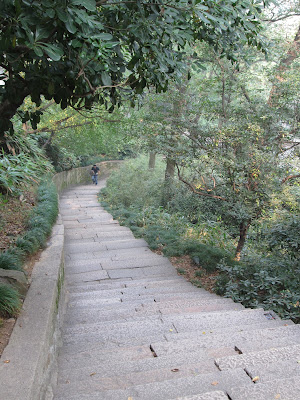Another fun fact is that the king entombed under Tiger Hill apparently had a general in his army named Sunzi (孙子), or in the west as Sun Tzu, who wrote the famous Art Of War.
Now starring Wesley Snipes!
Thus, I went to Tiger Hill with a great deal of anticipation, but was distraught at my very first sight once I entered the site, the humongous hordes of tourists:
"And they shall cover the face of the earth, that one cannot be able to see the earth...And they shall fill thy houses, and the houses of all thy servants, and the houses of all the Egyptians; which neither thy fathers, nor thy fathers' fathers have seen, since the day that they were upon the earth unto this day." - The Book of Exodus, Chapter 10, Verses 5-6.
The most famous landmark of Tiger Hill, the pagoda - officially known as the Rock in the Clouds Pagoda (Yun Yansi Ta 云岩寺塔) was visible from very far away, though as its name suggests, was continually blurred by mists and clouds that are naturally occurring in this part of China:
The area leading up to the pagoda was very scenic when not overrun by tourists:
There was also a great collection of Chinglish leading up to to the pagoda as well:
The pagoda - like the Leaning Tower of Pisa - is on a slant, rather than completely straight. Unlike Pisa, however, the pagoda is not slowly sinking into the ground!
I have no idea who this guy was, he just wanted my photo. So I made sure his buddy took one with my camera as well.
Heading down the other side of Tiger Hill, I found a lot more nature and a lot fewer tourists, which was a lovely change:
My adventure with Tiger Hill didn't stop after exiting it, though. This is because the exit of Tiger Hill leads to a bunch of highly overpriced 'special' taxis that happily take you anywhere you wish to go for an extremely steep price, almost 3 times what it would take for a standard taxi ride back to my university campus. As I've mentioned previously, I am extremely stingy with my money. That is not to say that I am short on money, it's just simply who I am. Thus, after lovingly telling the driver off in Chinese for being a dirty, rotten cheat, I ended up waking around the ENTIRE outside wall of Tiger Hill in search of a taxi. The scenery surrounding Tiger Hill was much less impressive than inside the walls:
After a half hour of walking along the outside edge of Tiger Hill, I finally found a taxi, who quickly - and cheaply - got me back to campus:
Until next time!



























































